| Reviews & Columns |
|
Reviews DVD TV on DVD Blu-ray 4K UHD International DVDs In Theaters Reviews by Studio Video Games Features Collector Series DVDs Easter Egg Database Interviews DVD Talk Radio Feature Articles Columns Anime Talk DVD Savant Horror DVDs The M.O.D. Squad Art House HD Talk Silent DVD
|
DVD Talk Forum |
|
|
| Resources |
|
DVD Price Search Customer Service #'s RCE Info Links |
|
Columns
|
|
|
Douglas Fairbanks Collection, The
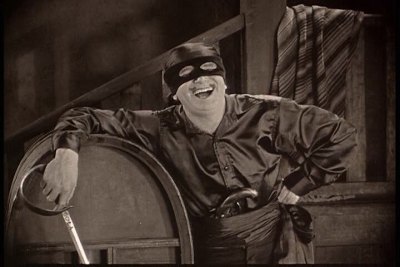 Douglas Fairbanks was one of the biggest movie stars of the silent era. His movies filled theaters around the world. The premiers of his films were huge social events. But he wasn't just a big star, he was also a shrewd businessman and a visionary when it came to the future of motion pictures.
Douglas Fairbanks was one of the biggest movie stars of the silent era. His movies filled theaters around the world. The premiers of his films were huge social events. But he wasn't just a big star, he was also a shrewd businessman and a visionary when it came to the future of motion pictures.
Born Douglas Elton Ulman in 1883, he changed his name to Fairbanks when he took the stage on Broadway. There he struggled for a time, but by 1915 he had appeared in several successful plays. Hollywood, hungry for talent at the time, offered him $2000 a week to start. Films were still looked down upon, but he had a wife and son to feed, so he reluctantly took it. He reportedly told a friend "Yea, it's a lot of money but, movies?" In Hollywood he had a string hit movies, and a year later his salary had increased to $10,000/week.
In his movies, Fairbanks usual character was a moral, energetic aristocrat who overcomes obstacles, shows up his snobbish peers, and gets the girl in the end. These comedies had a lot of action and stunts, but they were not outrageous slapstick, more farces. They were very popular, so much so that he was able to form his own production company in 1917. In 1919 he created, in a partnership with his friend Charlie Chaplin, Mary Pickford and director D. W. Griffith, a new movie studio; United Artists. This was a bold and innovative move, and it upset the balance of power in Hollywood, prompting one studio executive to exclaim "The lunatics have taken over the asylum!"
Though things were looking very good for Fairbanks financially, the box office on his movies was starting to slip just a bit. His pictures were slightly formulistic, and all had the same feel. People were getting used to them. He decided that he needed to do something new and different. That 'something' turned out to be swashbuckling action pictures.
In 1920 he released The Mark of Zorro. It was a critical and huge box office success. After one more try at a modern movie, (1921's The Nut,) he embraced the costume action movie for the rest of his career.
The forerunner of today's summer blockbusters, Fairbanks pictures had action, comedy, and a touch of romance all rolled up into one. But the emphasis was on action. Fairbanks did most of his own stunts, and would write scenes around a stunt he wanted to do. He was very athletic and a graceful acrobat. He never walked if he could run, and never ran if he could leap. But the key factor that made his movies so fun was the innocent arrogance he exuded. When being chased by a mob, whether it was the Queens guards or pirates, he never looked worried. Just the opposite, he looked like he was having the time of his life. He'd leap through a window, and while the villains were running past, sit down and savior a drink before running off. Watching him, you know that his character was in total control, no matter how uneven the fight was. In Don Q, Son of Zorro, he has aggravated a bar full of thugs. He smiles and leaps to the door only to find it locked. As his smile fades, one of the patrons pulls out a long dagger and asks with a snarl: "You think you'll leave this place?" Fairbanks face breaks out in a huge grin and he replies "When I'm ready." At that moment, you know the dozen thugs have no chance in defeating him.
Kino has released a magnificent boxed set featuring the first six of these Fairbanks classics on five DVDs. The set starts with his first period piece, The Mark of Zorro, and also contains The Three Musketeers, Robin Hood, Thief of Bagdad, Don Q, Son of Zorro (on the same DVD as Mark of Zorro,) and finishes with 1926's Technicolor feature, The Black Pirate.
Each DVD is reviewed individually below. Click on the title to jump down to a particular DVD.
The Mark of Zorro/Don Q Son of Zorro:
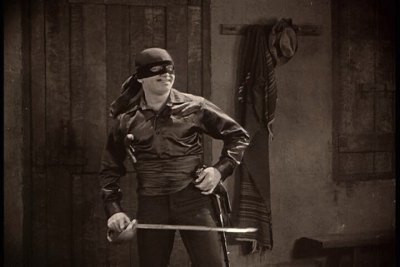 Most people are familiar with the story of Zorro. The masked hero has appeared in dozens of movies, and a popular TV show produced by Disney. But his first screen appearance was in this 1920 Douglas Fairbanks vehicle.
Most people are familiar with the story of Zorro. The masked hero has appeared in dozens of movies, and a popular TV show produced by Disney. But his first screen appearance was in this 1920 Douglas Fairbanks vehicle.
In 19th century California the people are being oppressed. The appointed Spanish Governor rules with an iron fist. Native Indians are beaten for no reason, and even priests are tied up and whipped. But the people have someone on their side, the masked outlaw Zorro! The story starts with a Spanish solider brandishing a "Z" carved into his cheek. He was beating an Indian for no reason when Zorro appeared and scarred him. The sergeant in command, Pedro Gonzales (wonderfully played by Noah Beery) brags to the foppish Don Diego (Douglas Fairbanks) that he'd like to meet Zorro face to face. Soon after Diego leaves, someone suggest to Gonzales that if he beats a native, Zorro will surely arrive. True to the prediction, as soon as the Sergeant attacks an innocent Indian, Don Diego returns in the guise of Zorro. He locks the doors and windows and fights the rotund Gonzales leavening him marked with a "Z".
Back at home, Diego's father is disappointed in his idle and frivolous son. If he won't work, the least he can do is marry. So he sends Diego off to court Lolita Pulido (Marguerite De La Motte.) Though the bored Don Diego can not get the fair Lolita interested in his handkerchief tricks or his latest hat, she is very interested in the dashing Zorro. Will Don Diego be able to win Lolita's heart, banish the corruption in California and stay alive while doing it?
This was a fun film. The action starts quickly and keeps on going. When there isn't a sword fight or chase, Fairbanks is giving a wonderful performance as the effete Don Diego, a very funny presentation. Another stand out performance was by Naoh Beery as the pompous Sergeant Gonzales. He played the oafish sergeant with just the right amount of bravado and stupidity.
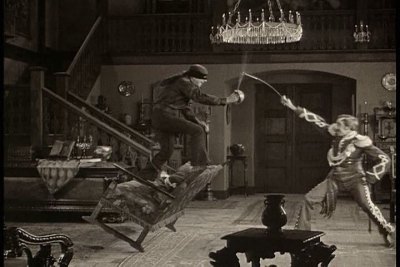 The direction is perfectly suited to the picture. It is fast and dynamic, keeping the film moving and didn't let it slow down. The director, Fred Niblo, would also direct Fairbanks in The Three Musketeers, and Valentino in Blood and Sand.
The direction is perfectly suited to the picture. It is fast and dynamic, keeping the film moving and didn't let it slow down. The director, Fred Niblo, would also direct Fairbanks in The Three Musketeers, and Valentino in Blood and Sand.
Though the acting was superb, and the direction was good, the main attraction to this movie is the action. There are some great sword fights, and breathtaking stunts. It's amazing to watch Fairbanks scamper up the side of a building and through the second story window as if it were nothing. He leaps and runs over the sets, all the while with a huge grin on his face. A very enjoyable film.
This film had a profound influence on heroic fiction, and still does today. Yes, this movie is based on a previously printed story, but the film was much more widely disseminated, and therefore had a larger impact. Many heroes that came after Zorro borrowed heavily from him. Mild mannered Clark (Superman) Kent and playboy millionaire Bruce (Batman) Wayne both come right from Don Diego, not to mention other heroes like the Green Hornet. The Lone Ranger was profoundly influenced by Zorro, and even Spider-man's witty banter in the middle of fights can be traced back to this film too. Influential and entertaining, quiet a combination.
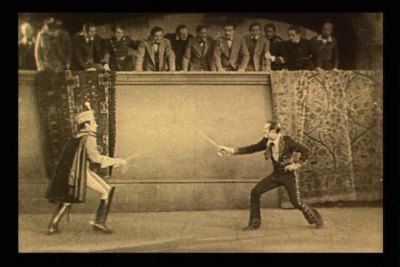 Also on this same disc is the sequel to Mark of Zorro, 1925's Don Q, Son of Zorro. In this movie Fairbanks plays Don Diego's son Don Cesar, who has been sent to Spain for his education. While showing off his skill with the whip, Don Cesar earns the enmity of the Captain of the Queen's guard, Don Sebastian, (played by the film's director, Donald Crisp) by accidentally flicking off the plume from his hat. Rescuing Sebastian from being trampled by a runaway bull only makes serves to make him more upset, but the Queen is impressed with Don Cesar's valor, and gets him introduced at court.
Also on this same disc is the sequel to Mark of Zorro, 1925's Don Q, Son of Zorro. In this movie Fairbanks plays Don Diego's son Don Cesar, who has been sent to Spain for his education. While showing off his skill with the whip, Don Cesar earns the enmity of the Captain of the Queen's guard, Don Sebastian, (played by the film's director, Donald Crisp) by accidentally flicking off the plume from his hat. Rescuing Sebastian from being trampled by a runaway bull only makes serves to make him more upset, but the Queen is impressed with Don Cesar's valor, and gets him introduced at court.
To make matters even worse, Don Cesar and Don Sebastian start courting the same beautiful heiress, Dolores de Muro (played wonderfully by Mary Astor.) The competition is too much, so when Don Sebastian accidentally kills a foreign ambassador, he sees his chance to remove Cesar from the picture by framing him for the murder. Don Cesar fakes his own death, and reappears as the masked Don Q, the whip wielding outlaw who is out to prove his own innocence.
This movie is just as enjoyable as the first. The stunts are still as daring and exciting, and the action is still almost nonstop. Fairbanks does a great job playing the dual role of Don Diego and Don Cesar. He still has all of the enthusiasm and verve of the earlier film. The fights in this sequel were staged better than the one's in the original movie. They were more elaborate and though out, very impressive looking. So impressive were Fairbanks' extraordinary stunts with the whip, they would influence the creators of Indiana Jones over half a century later.
The DVD:
Audio:
The both films had an original piano score written and performed by Jon C. Mirsalis. Of course, a full orchestration would have been preferred, but this accompaniment was suitable, even if it wasn't inspired. The music matched the tone of the movie, but didn't add a lot to the viewing experience. The sound quality was very good. There was no hiss of other glaring imperfections.
Video:
The video quality for Mark of Zorro was very good. The picture was filled with rich browns and amazingly clear for most of the film. There were some dirt and specks, more so in some parts than others. There was some significant emulsion damaged in one scene, obscuring most of the picture. It only last a few seconds though, and it does not occur during an action sequence. There were a few frames missing, due to splices, but these did not adversely effect the film. The digital compression was done well, with few artifacts present. I very nice looking copy of a great film.
I wish I could say the same for Don Q, Son of Zorro. This film is in much worse shape. The print they used is very badly scratched. The scratches and dirt are constant through the whole film, though they are not as bad later in the film, they never completely disappear. It does get distracting at times. Like most silent films, there are occasional frames missing, and a few slight spots of emulsion damage, but these are not nearly as bad as the other video imperfections. Luckily, the print is clear, and there is a good amount of detail. You can still make out the tassels on uniforms and the lace on the Queen's dress. The contrast is good overall, though there are a few scenes where is gets quiet dark. If the print has significantly fewer defects this would have been a top notch presentation.
The Extras:
Home Videos: 5 ½ minutes of film that Fairbanks mainly shot himself outside his office at UA. The most interesting part occurs at the end when Fairbanks practices some whip tricks that he would incorporate into Don Q.
Orson Welles intro to Mark of Zorro: A 6 minute prologue that Orson Wells filmed for the PBS series The Silent Years. Included in the introduction is a short except from Fairbanks 1917 film Wild and Wooly.
Fairbanks Vs. Dempsey: ½ minute newsreel clip of the champ and star goofing around in a ring. This is a much too short. As soon as the feature starts, it's over.It is too bad they couldn't have found a longer clip.
Making Life Worthwhile: A text feature that presents three chapters from Fairbanks' book.
Easter Egg: If you let the Orson Welles intro finish, instead of taking you back to the menu, you are treated to another Welles prologue and an except from Fairbanks sound picture, Reach for the Moon.
Final Thoughts:
Mark of Zorro would be the perfect film to introduce the art of silent pictures to someone who hasn't seen one before. It has all the charm and fun that audiences have come to expect from Douglas Fairbanks. While Don Q is also just as fun, the print may turn off viewers who are used to watching videos without constant print defects. I can see why Kino didn't issue this film on it's own. If think of it as a bonus movie, it is quite acceptable. Highly Recommended.
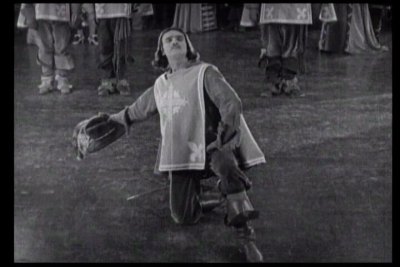 After Douglas Fairbanks Mark of Zorro did so well at the box office, he tried another modern farce, the kind that had made him famous. But 1921's The Nut did not draw the crowds in the way The Mark of Zorro did. So he abandoned films with a modern setting a concentrated on historical costume movies. For his next production, he decided to adapt Alexander Dumas' classic tale of chivalry and sword play, The Three Musketeers.
After Douglas Fairbanks Mark of Zorro did so well at the box office, he tried another modern farce, the kind that had made him famous. But 1921's The Nut did not draw the crowds in the way The Mark of Zorro did. So he abandoned films with a modern setting a concentrated on historical costume movies. For his next production, he decided to adapt Alexander Dumas' classic tale of chivalry and sword play, The Three Musketeers.
There is intrigue and deceit in the court of Louis XIII of France (Adolphe Menjou.) Cardinal Richelieu (Nigel De Brulier) is trying to increase his influence over the weak willed king and sets a trap for his Queen (Mary MacLaren.) Richelieu has discovered that the Queen has given a valuable broach, that was a present from the king, to her paramour, Duke of Buckingham (Thomas Holding.) He suggests that the King request the Queen to wear the broach to a royal ball, knowing she will not be able to produce it. When the Queen hears of the Kings' wish, she is distraught. There is no way she can retrieve the broach in time.
Enter young D'Artagnan. His father was a member of the King's Musketeers, and he wishes to become a member of that august organization. As he leaves his provincial town for Paris, his father tells D'Artagnan to fight as much as he can. That way he will quickly prove his courage and skill.
D'Artagnan takes his father's advice to heart. Having been turned down for a position in the Musketeers due to his lack of experience, D'Artagnan has a run in with three of those soldiers and challenges them all to duels and sets the same time for all three. When he arrives at the appointed place, the three Musketeers can not believe the audacity of the young swordsman. No sooner do they start to fight, than they get interrupted by a squad of Cardinal Richelieu's guards. The guards try to arrest the Musketeers and D'Artagnan, but the four of them manage to defeat seven of the Cardinal's men. Having come through this trial by fire, a bond is forged between D'Artagnan and his three new friends.
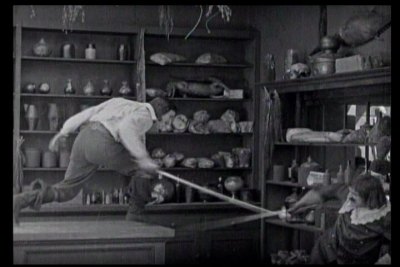 D'Artagnan takes lodging in the same boarding house that the Queen's seamstress, Constance (Marguerite De La Motte) lives. The two become friendly, and when D'Artagnan saves Constance from being interrogated by the Cardinals guard, the Queen's aide learns to trust D'Artagnan.
D'Artagnan takes lodging in the same boarding house that the Queen's seamstress, Constance (Marguerite De La Motte) lives. The two become friendly, and when D'Artagnan saves Constance from being interrogated by the Cardinals guard, the Queen's aide learns to trust D'Artagnan.
Richelieu's trap is sprung on the Queen and Constance reveals the problem to D'Artagnan. He, along with his three companions, set out to travel to England to retrieve the broach. But Richelieu has been warned, and with the resources of a country at his fingertips, sets out to stop them.
This was a great follow-up to Mark of Zorro. There is just as much action, if not more, a slightly more complex story, and a more interesting setting. Fairbanks ramped up the production values on this film too. The sets were much more elaborate, and accurately decorated, a trend that he would continue with. The streets of Paris (though undoubtedly cleaner than they really were in the mid 1800's) looked authentic. From the cobblestone roads to the street vendors, attention was paid to realism.
The movie itself was very enjoyable. Fairbanks, though looking a little old to play D'Artagnan, does a magnificent job. He leaps and runs and pounces all over the sets, and his swordplay, though not very realistic, steals the show.
The three Musketeers themselves are overshadowed by Fairbanks enthusiastic portrayal. They seem lifeless next to the exuberant Fairbanks. Adolphe Menjou does an adequate job as the King, but the best supporting actor without a doubt was Nigel De Brulier as Cardinal Richelieu. He played the role in a very understated manner, which made him seem all the more sinister. An excellent performance by the man who would revive the character in Fairbanks' 1929 sequel, The Iron Mask, and even play the same role in the very forgetable1935 remake staring Walter Able.
The DVD:
Audio:
The sound track was a synthesizer version of the original 1921 score preformed by Brian Benison and the "Elton Thomas Salon Orchestra." This is the same group that preformed the infamous score to Fairbanks Robin Hood. While this score is much less objectionable than the one to Robin Hood, I still do not like the electronic sound that the synthesizers provide.
The sound quality is very good. They high and lows come through loud and clear, and there is no evidence of hiss. Minimal use was made of the front soundstage in the stereo mix.
Video:
The master that was used seems to be an amalgam of at least three other prints. There it was fairly easy to determine which copy each scene came from due to the condition of the video.
The first source print looked outstanding. Very clear with a full range of tones. The detail was excellent. There were only minor amounts of dirt and speckling. This print was used most often through the film.
The second source print was also very good, but it was more washed out. There was not as much contrast and the range of tones was less. There still was a very good amount of detail, but the blacks were more a dark gray, and there were some details lost in bright areas. This print looked a little like you were watching it with the brightness turned up a tad too high. Still a nice looking copy. This print was used a good deal too, but less than the first one.
The third print was the worse. Luckily it was utilized the least of all of them. The picture in this source was very soft and blurry. It was much darker than the other two, and it had a good deal of scratching. These sections were still watchable, but in contrast to the other two prints, the differences were very evident.
The Extras:
This was the only DVD in the Douglas Fairbanks Collection Boxed set that did not have supplemental materials, unfortunately.
Final Thoughts:
In his second costume piece, Douglas Fairbanks solidified the type of role he would play for most of the rest of his career. He was dashing and exuberant and really put on a good show. This movie is a joy to watch, one of my favorite Fairbanks films. It has action and romance, plotting and deceit, and D'Artagnan is a wonderful character. You can't help but laugh as he challenges Musketeer after Musketeer to duels. Highly Recommended.
The Movie:
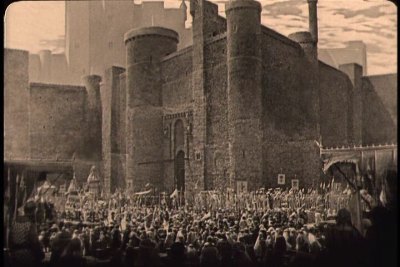 The Douglas Fairbanks movie for 1922 was his telling of the Robin Hood legend. He had been fascinated by the story since boyhood, but was never convinced that it would make a good picture. After The Three Musketeers was such a huge success, he realized that costume action films were what he was best suited for in the eyes of the public, and was looking around for another such project. When the concept of Robin Hood was brought up, he initially rejected it, but then realized that it would be the prefect vehicle. There would be a lot of stunts, a romantic interest, fights and jousts, and it would include the themes of fairness and chivalry that his other films promoted.
The Douglas Fairbanks movie for 1922 was his telling of the Robin Hood legend. He had been fascinated by the story since boyhood, but was never convinced that it would make a good picture. After The Three Musketeers was such a huge success, he realized that costume action films were what he was best suited for in the eyes of the public, and was looking around for another such project. When the concept of Robin Hood was brought up, he initially rejected it, but then realized that it would be the prefect vehicle. There would be a lot of stunts, a romantic interest, fights and jousts, and it would include the themes of fairness and chivalry that his other films promoted.
To make this picture, Fairbanks and his team did a huge amount of research. They studied the legend itself, but also the clothes and amour, how people lived, how they cooked and what they ate. They accumulated a library's worth of books and documents for the project.
There was a problem though. Fairbanks wanted to spend a million dollars on the production, and the industry was in a slump. Money was hard to come by so he financed the entire picture out of his own pocket, and was the sole owner of the film.
Fairbanks commissioned the biggest set ever built in Hollywood for a silent film. The castle that was constructed covered ten acres. It was ninety feet tall, and historically accurate in every detail. Fairbanks gave the go ahead to start on the set before he left for New York on some business. As soon as he stepped off the train upon his return, he asked about the castle. It was finished, and he sped off to see it. Fairbanks toured the set for hours, inspecting every detail. At the end of his inspection, he announced that the film would not be made! The set was just too grand, to eye catching. He was an intimate actor, and would be lost on such a stunning set, he just wouldn't be able to compete. So the picture was cancelled.
Director Alan Dwan is responsible for changing Fairbanks mind. Dwan convinced Fairbanks to come back to the set. The director pitched a scenario for the movie: Robin Hood is fighting a large group of knights. He starts getting overwhelmed, so he runs up the stairs to a walkway overlooking the main hall. But more knights enter from the other end, cutting off his retreat. Robin Hood jumps up on the balustrade fighting them, but there is no hope. Dwan stopped talking. "Yeah, then what do I do?" Fairbanks asked. Dwan climbed up onto the balustrade and jumped onto a curtain that was hanging next to it. Underneath was a slide. He slide all the way to the floor fourth feet below, then ran out the giant door to freedom. "I'll do it!" Fairbanks yelled down.
The castle was the talk of Hollywood. One day Charlie Chaplin asked Fairbanks if he could borrow it for a scene in a film. When Fairbanks wondered what he wanted it for, Chaplin showed him the gag he concocted: The large drawbridge lowered. Chaplin walks out the a cat under his arm. He lets the cat out, picks up a quart of milk and the newspaper, and walks back in as the drawbridge slowly closes. Though Fairbanks loved the gag, he didn't want his castle to be used in a comedy.
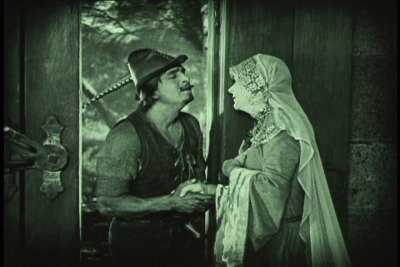 After spending so much time and money on the production, Fairbanks was worried, rightly so, that a poverty row film studio would rush another version into production and release it just before his, to capitalize on the press that his movie was getting. After all, the story was in the public domain. To help minimize the chances of that happening, he officially entitled his movie "Douglas Fairbanks' Robin Hood."
After spending so much time and money on the production, Fairbanks was worried, rightly so, that a poverty row film studio would rush another version into production and release it just before his, to capitalize on the press that his movie was getting. After all, the story was in the public domain. To help minimize the chances of that happening, he officially entitled his movie "Douglas Fairbanks' Robin Hood."
Like most of Fairbanks costume movies, the story of Robin Hood is well known today. The Earl of Huntingdon (Douglas Fairbanks) is off on a Crusade with Richard the Lion-hearted (Wallace Beery.) Having beaten Sir Guy of Gisbourne (Paul Dickey) in a joust (although Sir Guy tried to cheat) the King has assigned Huntingdon as his second in command, much to the distain of Sir Guy.
With Richard gone, his brother Prince John (Sam De Grasse) is left in charge. John quickly puts his corrupt cronies into positions of power and turn the idyllic England into a cruel and brutal place.
On his way to the Holy Land, Huntingdon receives word of Prince John's deeds. Before he can inform the King, he gets framed for desertion. Managing to escpape with the help of his squire, Little John (Alan Hale Sr.,) the Earl returns to England to protect the people until its rightful sovereign can return. Still a wanted man, he takes on the persona of Robin Hood, and forges the petty thieves and outcasts of Sherwood forest into a fighting force.
Robin Hood ended up costing $1.4 million. A huge sum in those days, twice as expensive as D. W. Griffith's lush Intolerance. The risk was well worth it though, Robin Hood ended up making $2.5 million dollars and it received the Photoplay Medal of Honor for 1922.
How does the film stand up today? Very well, for the most part. It seems a little long winded at the beginning. The first half sets up the whole story, and it is an hour into the movie before Robin Hood makes his first appearance. After that things move quickly. Robin and his men keep the Sheriff of Nottingham running in circles. There are many fun stunts, including the one that convinced Fairbanks to make the movie, of course.
As far as the acting goes, this was an excellently cast film. Sam De Grasse was a wonderfully villainous Prince John, but Wallace Beery was the best supporting actor playing the noble King Richard. Fairbanks shines as always. is taunting of the knights that are chasing him and carefree demeanor add a lot of humor to the film. Thought his gestures are broad and dated by today's standards, they don't appear farcical.
The direction is a tad slow in the first half, but the action scenes are shot well, and the editing is very good. There is just the right amount of tension and suspense (though you never really think that Robin will be captured or hurt.) Like the other Fairbanks movies, a very enjoyable film.
The DVD:
Audio:
The musical accompaniment for Robin Hood is the original 1992 score preformed by Eric Behelm. While the sound quality itself is very good, something has to be said about the quality of the score itself. It is preformed on a synthesizer, and is totally inappropriate for this movie. A piano score would have suited this film much better. The electronic slightly tinny sounding synthesizer just ruins the mood of the film for me. I can't imagine why Kino opted for the soundtrack. Surely a piano score would not have cost any more. One of Fairbanks biggest movies really deserves a full orchestra, but barring that a three piece ensemble would have sounded very good. It is a shame that this disc is flawed with inappropriate music.
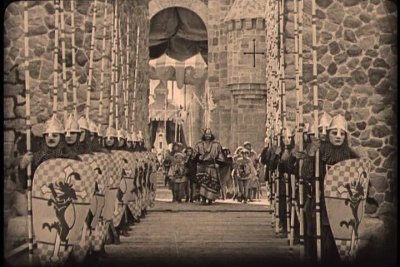 Video:
Video:
This print comes from a 35mm negative, with tinting added, and projected at "the correct projection speed." I wish they would have stated what at speed they did project it. The 133 minute speed is longer than the previous Kino release of 120 minutes, that seems to imply they either included extra footage, or ran it at a slower speed. There really wasn't a set speed for all movies in this period, but most the "silent speed" of 16 fpm is really too slow for this film. It was originally intended to run at 22fps according to at least one source. In any case, the speed looked good. The picture wasn't jerky and the movement didn't look unnatural. While not a perfect print, it is very good. There dust and scratches are minimal, and the print has a full range of tones. The huge castle set comes through in fine detail, and only a little grain. A very good presentation of a classic movie.
The Extras:
This disc has a couple of fun extras. First there are three minutes of outtakes. Most of these are alternate takes, rather than goofs or major blunders. It was interesting to see.
The other bonus is an except from a Will Rogers short, Big Moments from Little Pictures. While I would have much appreciated the full film, which appears on the Slapstick Encyclopedia boxed set, this 6 minute except is great to have. Rogers parodies Robin Hood and Fairbanks. His Robin is very foppish and carefree, as are the Merry Men. A cute send up.
Final Thoughts:
This movie was believed lost for many years. As the stories about the sets and the production values circulated, the yearning to see the movie grew. Luckily, a copy turned up in the late 50's, but it was still rarely seen, and when it was shown, it filled theaters once again. Not only can you see a very good copy of this film, but you can have a DVD of this classic for your very own. This Kino disc, even with the less than ideal synthesizer accompaniment, is a great disc. Highly Recommended.
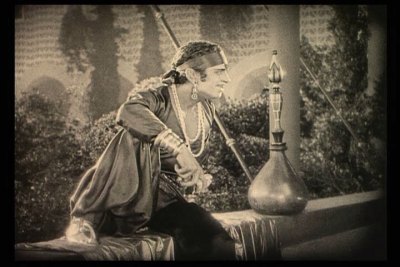 Douglas Fairbanks knew he could never surpass the sets he used for his 1922 movie Robin Hood, for which he commissioned an authentic castle that sprawled over ten acres. For his next movie, he decided that if he couldn't make a more grand production, he would create a more lavish and spectacular one. He would base his next movie on the Arabian Nights.
Douglas Fairbanks knew he could never surpass the sets he used for his 1922 movie Robin Hood, for which he commissioned an authentic castle that sprawled over ten acres. For his next movie, he decided that if he couldn't make a more grand production, he would create a more lavish and spectacular one. He would base his next movie on the Arabian Nights.
Young (and handsome) thief Ahmed (Douglas Fairbanks) lives by his wits on the streets of Bagdad. Stealing for food and entertainment, he manages to purloin a magic rope, that will raise straight up into the sky and allow the owner to climb it. Using this rope, he sneaks into the Caliph's palace. While robbing it, he catches a glimpse of the Caliph's daughter, the Princess. Seeing her beauty, he is instantly smitten. Instead of carrying of the treasure he has found, he steals only one the Princess' slippers.
Soon the Princess' birthday arrives, and she must pick a suitor to marry. Princes from far and wide come to try for her hand, including a Mongol Prince. But the Mongol does not come for marriage, he wants to conquer the city, and uses the birthday as an excuse to gain entrance.
Wanting to see her again, Ahmed steals some regal clothes (and presumably a horse) and is announced as a prince from a far off land. While no one is looking, Ahmed climbs up to the Princess' balcony and is able to charm her. The Princess falls in love with the thief, and much to the dismay of the other suitors, chooses Ahmed as her groom.
But things don't go smoothly for Ahmed. It is discovered that he is not a prince. He is flogged and thrown out of the palace. Still having to choose a mate, the Princess sends them all on a task. She wants them to travel to distant lands, and the one who brings back the rarest treasure, she will marry. The princes set off on their quest, but Ahmed does too.
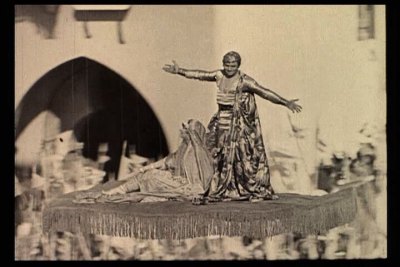 Filled with lions, apes, elephants, flying carpets and winged horses this film is a great spectacle. There is always something interesting to watch. Director Raoul Walsh (who would go on to direct Humphrey Bogart and Ida Lupino in High Sierra among many, many others) perfectly compliments Fairbanks' script. The blocking of the frame and composition make many of the shots look like paintings. He deftly used matte painting to make the film look even more grand than it was.
Filled with lions, apes, elephants, flying carpets and winged horses this film is a great spectacle. There is always something interesting to watch. Director Raoul Walsh (who would go on to direct Humphrey Bogart and Ida Lupino in High Sierra among many, many others) perfectly compliments Fairbanks' script. The blocking of the frame and composition make many of the shots look like paintings. He deftly used matte painting to make the film look even more grand than it was.
Douglas Fairbanks, 40 at the time he filmed this, looks years younger. Though he has a hard time pulling off youth a few years earlier in The Three Musketeers, in this picture you never question that he's a young rouge living off his wits. He is as active as ever, scampering up magic ropes and climbing up the sides of buildings as if gravity were a mere suggestion that really didn't apply to him.
The his costars did an admirable job keeping up with the fast paced Fairbanks who usually steals all the scenes he's in. Luckily, Fairbanks had a flair for casting wonderful villains in his movies, and this one is no exception. Sojin, who played the evil Mongol Prince, was marvelous. He was evil and sinister without over acting or hamming it up. Sojin would play many oriental villains in the silent era, but would find little work after sound arrived due to his accent and limited English. Julanne Johnston, the romantic interest, didn't have a lot to do, the problem with most of Fairbanks heroines. She looked stunning in her robes and whisper thin veils, but just didn't have a lot to do in the film besides look pretty. The female cast member who stole the show was Anna May Wong as the Mogol slave. She played her duplicitous role perfectly and her beauty made her seem even more dangerous.
A lot of movies have borrowed heavily from this film. Aladdin from the 1992 Disney movie of the same name, is almost exactly the same character as the one Douglas Fairbanks played in this movie: A young lovable thief who lives off his wits yet has a heart of gold.
Like the other Fairbanks movies of this period, this one is filled with action, suspense, thrills and excitement. The plot may be simple, but the film sure is fun. A great flick.
The DVD:
Audio:
The sound track is provided by the Mont Alto Motion Picture Orchestra based on the original 1924 cue sheets. Mont Alto has been around for around for about ten years specializing in live accompaniments to silent movies. This is the tenth movie that they have recorded a music track for. Though I have heard of them before, this is disc is the first time I have heard their music. I was very impressed. The score worked very well, accenting the mood, and complimenting the action, but never becoming intrusive. This five piece ensemble's thoughtful arrangement added another dimension to the picture. I can only hope that they crop up on more DVDs in the future.
The sound quality was very good. The stereo mix sounded full and clear. There was no hiss or tape noise that sometime accompanies older soundtracks. One of the best sounding silent era DVDs I have had the pleasure to screen.
Video:
The video was spectacular. There is very nice detail and contrast throughout the film. The smoke curling up into the sky during the introduction has form and definition. The features on the Caliph's uniform are clear and easy to see. There are only occasional print imperfections, and these are slight. A few scratches in instances of dirt are present, but at a very low level. There is a spot or two of slight emulsion decomposition but these only occur rarely, and never for long. They look more like someone got a few drops of water on the print before running it. The print is tinted during various scenes. The tinting is even across the whole frame, and is not splotchy or uneven. Though I am not a huge fan of tinting, it worked well on this film.
The encoding was very well done. There was no aliasing, and only the most minor of digital artifacts. The smoke was smooth and not pixilated, and the background didn't waver. A very impressive looking disc, one of the best silent era DVDs I've seen.
The Extras:
Kino has really been a leader in the area of including extras on silent features. Often silent movies are released with nothing more than a scene selection menu. This disc includes:
Filmed Introduction by Orson Welles: A 5 minute prologue that Orson Wells filmed for the PBS series The Silent Years. It is ironic that Welles talks about film preservation, but this introduction from 1971 is in worse shape than the feature.
Outtakes: 19 minutes worth of alternate takes. Some of these are very rough, with a lot of decomposition. A very nice extra.
Matte Photography Outtakes: The extra deconstructs a matte scene, and show how the matte was placed and the actors filmed. A very interesting an worth while bonus. It was amazing how far the use of matte photography had come by the mid 20's.
Excerpt from Paul Leni's Waxworks: A three minute clip that shows the Fairbanks inspiration for The Thief of Bagdad.
Except from Mêlées' Arabian Nights: A 7 ½ minute clip from The Palace of Arabian Knights directed by Georges Mêlées in 1905. This is about half of the entire film, and I wish they would have included the entire movie. The picture is very soft and blurry, and the sound track was very noisy, but it is still an interesting piece.
There is also a text piece about the score, and several pages from the souvenir program. Altogether an amazing set of extras.
Final Thoughts:
You can tell a lot of thought and effort went into the creation of this DVD, and it has paid off. This is an fantastic disc. This is one of those times when everything came together just right. The print is excellent, with very little print damage, and the encoding was properly done. The musical score added a lot to the film, illustrating how important the musical selection can be. All this is on top of an excellent movie that is full of spectacle and grandeur. A delightful romp through a Bagdad that never existed, but we all wish did. If only all silent era DVDs could live up to the high standards set by this disc. DVDTalk Collector's Edition.
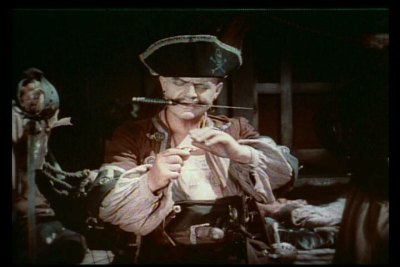 This was Douglas Fairbanks last real hit. The films he did after this one did a respectable box office, but weren't smash hits like Mark of Zorro and Robin Hood.
This was Douglas Fairbanks last real hit. The films he did after this one did a respectable box office, but weren't smash hits like Mark of Zorro and Robin Hood.
Douglas Fairbanks was always trying to improve the look and feel of his movies. When he settled on a pirate sea adventure for his next film, Fairbanks decided that the movie needed to be in color.
This wasn't as strange as it may sound. Color films were not unheard of, even in the 1920's. Around the turn of the century, color was added to film by having it painted on. Women were hired to apply paints with very fine brushes onto the nitrate print film itself, one frame at a time. This, of course, was expensive and inexact. As film grew longer and the number of prints needed grew, the process become too expensive and time consuming. In 1906, Pathé patented a stencil process where the areas to be colored were cut out of one print, then placed over a second positive print. The pair were then dyed, allowing the bottom copy to retain the color. This process worked very well, but it was still time consuming and expensive. By the mid 1910's the process was all but abandoned.
There was also the Kinemacolor system that used a spinning wheel with red and blue green lenses in front of the camera and also the projector. The color was fairly accurate, but the imperfections in the process caused eye strain and headaches to the viewers, so the process never caught on.
For this sea epic, Fairbanks settled on a color system invented by a small company named Technicolor. Their system used a modified Bell and Howell camera. There was a prism inside that split the image, and then sent the light through two different color filters and exposed two negatives. From this, two color positives were made that were cemented together. When projected, a color film appeared.
There were limitations to this system. Due to the absorption of light by both the prism and filters, a large amount of light was needed on the subjects. It took much longer for the film to be developed and cemented, and certain colors did not show up well. Even given these problems, Fairbanks thought the film would be better in color than in black and white. He was right.
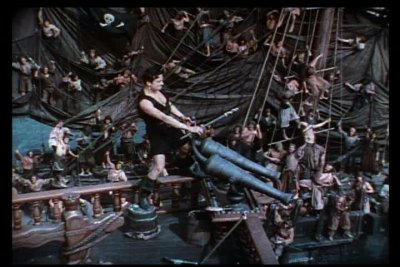 Fairbanks plays man, Michael, who is unlucky to be traveling on a ship that is captured by pirates. After looting the ship, the brigands tie the crew to the mast and blow the ship up. Michael and his father survive, and manage to swim to an island, but the exertion is too much for the older man, and he dies soon after reaching safety. Fairbanks vows on his father's grave to bring the men who caused his death to justice.
Fairbanks plays man, Michael, who is unlucky to be traveling on a ship that is captured by pirates. After looting the ship, the brigands tie the crew to the mast and blow the ship up. Michael and his father survive, and manage to swim to an island, but the exertion is too much for the older man, and he dies soon after reaching safety. Fairbanks vows on his father's grave to bring the men who caused his death to justice.
As luck would have it, the pirates land on the same island to hide their treasure. Michael appears and states that he'd like to join their crew. When they laugh at him, he challenges the captain to a fight, and wins handily. The first officer (Sam De Grasse) is still not convinced, so Michael offers to capture the next ship that they sight single-handedly, without firing a shot.
At dawn the next morning, they spot a ship laden with cargo. In the most exciting scene in the movie, true to his word, Michael captures the ship all by himself. During the action Michael ends up high in the rigging, and, in a stunt that will become a standard in most pirate movies after this one, he pulls out his knife and jumps into the sail, slicing it as he descends to break his fall.
Because of his daring and bravado, the pirate crew decide that he should lead them. He accepts and declares that from now on, he will be known as the Black Pirate!
Meanwhile the crew find a young princess on the recently captured ship (Billie Dove.) As the crew draws straws for her, Michael interrupts them. Instead of blowing the ship up, they will ransom it. And to ensure the ransom is paid, they will hold the princess hostage. The first officer doesn't like the idea, he wants the girl for himself. Michael, of course, is planning on helping the girl escape. But when the Black Pirate is caught helping their hostage escape, the crew turns on him, and makes him walk the plank. How can he possibly save himself, the princess, and avenge his father?
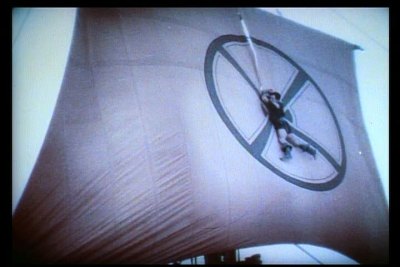 This swashbuckling drama was exciting, even though it has some flaws. After the Fairbanks captures the cargo ship, the action tapers off quite a bit, not really picking up again until the last reel or two.
This swashbuckling drama was exciting, even though it has some flaws. After the Fairbanks captures the cargo ship, the action tapers off quite a bit, not really picking up again until the last reel or two.
Douglas Fairbanks puts on another great performance, but Billie Dove, who was hired since her complexion photographed well in Technicolor, spends much of the movie just looking scared or bored. Sam De Grasse, who played Prince John in Robin Hood, does a wonderful job as Fairbanks' nemesis.
The big star of this film though is the color. It feels very strange at first to be watching a color silent film. While the Technicolor process used for this film was not nearly as successful as the three strip version that they would invent in later years, it does add a unique character to the film.
After the film was released, there were a lot of problems with the Technicolor prints. The film would cup and bow at random places in the reels, causing the film to skip and jump. There were other problems with projection too. It was hard to get the right amount of light to go through the film. At the level a black and white films was shown, the colors were too dark, but higher light levels risked melting the film. Due to the problems he had filming and problems with the prints afterwards, Fairbanks abandoned the color process.
The DVD:
Audio:
The soundtrack consists of the original 1926 score being preformed by a small orchestra under the direction of Robert Isreal. The score is very good, and adds a good deal to the viewing experience. The sound quality is also very nice, though I could have used a little more bass response.
Video:
The restored two strip Technicolor print is astounding to watch. It is not bright and bold like the later Technicolor films, but the colors are fairly accurate. Though there are several problems with the color, most of them are probably inherent in the filming process rather than a defect in the print, but I'll list them here for convenience's sake. The colors have a slightly washed out look to them, probably because of the large amounts of light needed for the process to work. The whole picture has an odd tone to it, as if the picture had been colorized. I chalk it up to the fact that the two strip process could not pick up yellow. Some of the darker scenes have odd shadow in patches of black, it almost looks like emulsion damage, but it can't be attributed to that. Even with these defects, the colors do look nice. You will be surprised the first time you see it.
Aside from those quibbles, the DVD looks very nice. There are hardly any scratches and dirt on the print, something us silent movie fans have had to live with up till now. The detail in the picture is excellent. You can clearly make out the grain in the letters of the father's tombstone and the insignia on Fairbanks' ring. The lines are very clear, especially for a film this old. Overall an excellent DVD.
The Extras:
There are a couple of interesting bonus features on this disc. First off is a commentary by film historian Rudy Behlmer. This was originally recorded for the LD release of this movie. I was looking forward to this, but was slightly disappointed. His delivery was very wooden, as if he was reading from a script. The information he gave was not scene specific either. He talked a lot about how many people were effected and admired this movie, and read a lot of quotes from them. The information content picked up as he went along though. Later he talks about the actors and what they went on to do. Overall, it was an interesting commentary, and it adds a lot to the DVD, but not as much as I was hoping.
There is also a 19 minute reel of outtakes narrated by Rudy Behlmer. It was really interesting to see some of what went on behind the camera and what wasn't used. A great addition to the disc.
Final Thoughts:
The Black Pirate is a very entertaining film. It has some classic stunts, and great action scenes. By some estimates, over 95% of the silent movies that were made in color are lost. This rare chance to see a feature with a restored two strip Technicolor process image makes this DVD a no-brainer. Highly recommended.
Final Comments:
After The Black Pirate, Fairbanks made three more silent movies: The Gaucho, The Man in the Iron Mask, a sequel to The Three Musketeers, and 1929's The Taming of the Shrew costarring his wife, Mary Pickford. The last was a critical and box office flop. But about the time he was filming The Black Pirate, he knew that his career was coming to a close. Being in his mid 40's Fairbanks could no longer safely perform the spectacular stunts and tricks that his films were famous for. So he starting looking ahead to the future of motion pictures. He was one of the first people to make a feature length color film, and he enthusiastically embraced sound when it arrived. One of his most lasting achievements occurred in 1927, when he help found the Academy of Motion Picture Arts and Sciences, (the group that hands out the Oscars each year,) and was elected as its first president.
Fairbanks made his first feature talking picture in 1930, Reaching for the Moon. (An excerpt is provided on the Zorro DVD as an Easter egg.) After a couple of years off, he made Mr. Robinson Crusoe in 1932, and the following year announced his retirement. Though he did make one more film, 1934's Private Life of Don Juan, his tenure as one of Hollywood's biggest stars was over. Sadly, by the late 1930's he was main forgotten. Not liking the direction the movie industry was going, he spent his last years traveling the world and relaxing at his Santa Barbara home. He died of a heart attack in 1939 at the age of 56.
Kino's collection of Fairbanks' best work is a treasure trove for any film buff. This collection presents Douglas Fairbanks at the peak of his career. When he had the money, power, and enthusiasm to make the pictures he wanted to make, the way he wanted to make them.
Kino has included a nice set of extras on the DVDs. While no one would fault Kino for putting these movies out as bare bones editions, like most other silent moves, they have gone the extra mile to include some very rare and intersting supplements. They should be applauded for raising the level of quality on silent era pictures. The only regret I have is that Kino didn't include Fairbanks last two costume movies in this set, especially since they have released those two movies on DVD. But even with those titles missing, this set is a must have for fans of early cinema. Highly Recommended.
|
| Popular Reviews |
| Sponsored Links |
|
|
| Sponsored Links |
|
|
| Release List | Reviews | Shop | Newsletter | Forum | DVD Giveaways | Blu-Ray | Advertise |
|
Copyright 2024 DVDTalk.com All Rights Reserved. Legal Info, Privacy Policy, Terms of Use,
Manage Preferences,
Your Privacy Choices | |||||||













